SEASONS GREETINGS
I take this opportunity to wish you all our Season’s Greetings, and may you all benefit from Vetiver Grass Technology, and in doing so, share what you know with others, in and outside of your community. I also take this opportunity to thank those of you who have contributed to our knowledge base. Your support and feedback is invaluable.
Regenerative Agriculture
This month I want to put some focus on Regenerative Agriculture. Soil health in its broadest sense is
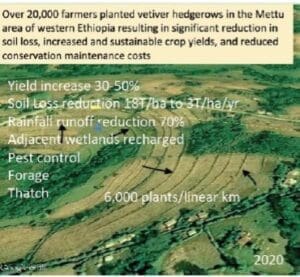
declining at an accelerating rate, due, amongst others, to increase pressure on the land, continuous and overuse of agricultural chemicals, poor farm management systems, and damage from extreme rainfall events — often associated with management practices that do not protect the land.
The aim of Regenerative Agriculture (RA) is to regenerate soils, optimizing yields with cost-effective, low external input, and low-emission methods that work with, and do not harm nature.
There is plenty of evidence generated over the past 30 years that Vetiver grass can be a very effective tool in enabling and speeding up the regenerative process and supporting other components of the RA process particularly in the tropics. By using and planting vetiver in various configurations vetiver protects the land from extreme rainfall events, provides for soil and water conservation, enhances soil health (in all aspects) and nutrient transfer to the farm crop, reduces soil temperatures and increases soil moisture content and soil carbon, through its large leaf biomass (as a mulch) and its massive root system for carbon storage. The vetiver hedgerows in photo 1 have stopped erosion, reduced rainfall run off, improved soil moisture and soil health, and reduced the incidence of plant pests. The leaf biomass is used as mulch, fodder, thatch, all of which is eventually incorporated in the soil. Important off farm benefits as a result of increased ground water recharge from farm vetiver applications were the revival of adjacent wetlands and the associated wildlife.
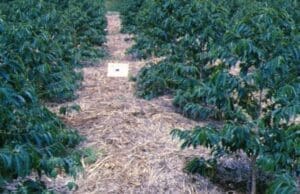
Crop rotation and greater use of the biomass for mulching would further provide for a sustainable production system with reliance on minimum sternal inputs. Another example from Ethiopia (Photo 2) is the application of vetiver supporting 20,000 ha of commercial coffee (especially for mulching) since the 1990s. Apart from direct farm benefits there are many off-farm watershed and river basin benefits that are rarely included in economic analysis – they should be – because they are probably a lot greater than we think.
Regenerative Agriculture (RA) is not a new concept, but is a useful terminology to get farmers, and their supporting institutions, to put focus on reappraising their current generally unsustainable practices that are deleterious to the soil and to biodiversity.
Regenerative Agriculture from Kenya
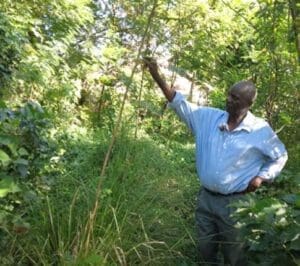
Caleb Omolo has worked with communities and vetiver for many years. When he took over his father’s farm at the foot of the Kisi Mountains in Migori County of Kenya, the land was badly eroded and degraded. He planted vetiver hedgerows to correct the erosion problems and then moved to an RA farming system. Today he farms with no dependence on external ag chemical inputs, and on one acre had a thriving food forest (see this video: REVOLUTIONARY FARMS #2: YouTube).
He describes RA:
“The name regenerative farming was coined (1946) by the Rodale Institute, Pennsylvania USA. Jerome Rodale noticed the problems, on US farms, created by large scale use of industrial chemicals and the creation of hard soil hard pans. He came up with a new farming system that works with soil ecology. lt is also known as biological farming. Biological farming was not new …. An Agricultural Testament by Albert
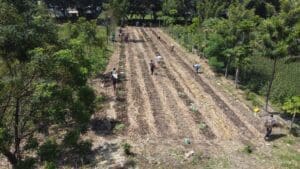
Howard and Farmers of Forty Centuries by F. H. King describe how the farmers of India, Japan, Korea , and China following biological principles. They provided detailed information on how to work with soil biology and harness the bacteria and soil microbes to build the soil to produce a food and integrated livestock system without harming the environment. RA recycles farm waste and livestock waste to grow microbes for soil building. Domestic animals are used to stimulate plants nutrients through controlled grazing that encourages plants roots to transfer nutrients for plants growth to replenish what the animals consumed. Permaculture is a set of ethics and principles for designing sustainable human settlements. RA follows permaculture principles that works with nature. In my 12 years working with Vetiver grass l found that Vetiver grass is a very effective plant for controlling soil erosion, improving water holding
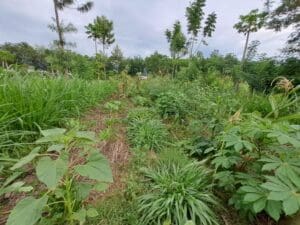
capacity when applied as mulch, humus building and repairing degraded land under any soil conditions, sandy rocky and clay. Vetiver grass breaks the soil hard pans associated with “dead soils” and works with the microorganism that mine nutrients and minerals from sand rocks and pebbles making them available. RA practitioners prefer Vetiver grass over other types of grasses for land Restoration because of those characteristics.”
Caleb has trained about 5,000 people in RA using his farm as a training center. He and Christian Mahoka hope to extend this training to other areas of Kenya with some funding support from TVNI.
Regenerative Agriculture from Thailand
Some of the most successful moves towards RA using vetiver has taken place in Thailand over the past 35 years — regretfully we have not paid enough attention to it.

“Vetiver grass is the best, easiest, and cheapest choice for conserving and increasing soil fertility in the agricultural system. We have studied vetiver and have enough information that from now on we should move to a vetiver planting campaign (policy). This may have to start by teaching young people …… Thai people have got to know “vetiver”, (once considered a weed) as a natural plant that if used properly will improve soil fertility and will conserve soil and water. Therefore, there is a need for a promotion campaign for Thai people to know and grow more vetiver grass…. including promoting farmers to embed vetiver into their agricultural operations …. If incentives, such as a reduction in interest on agricultural loans, were to be introduced, probably all farmers would plant vetiver grass.” …. Prof. Dr. Somchai Anusonpornperm, Kasetsart University, Thailand.”
Sergeant Major Khian Soi Som a Farmer from Phetchaburi Province, Thailand, received the Ist Royal Shield Award in 2006
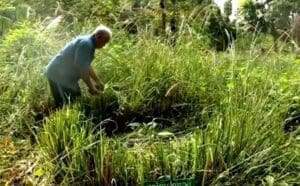
“Before planting vetiver grass my land was farmed as my ancestors did. For my generation, farming was becoming less productive, we switched to other crops, everything died because the soil condition was bad. The soil had become highly alkaline.”
Sergeant Major Khian attended Huai Sai Royal Development Study Center where he learned about vetiver grass. … “At first I didn’t believe that the roots of the vetiver grass could penetrate deep into the hard soil. Until one day the excavator came to dig and modify the area. It was found that the area where vetiver was planted was much easier to dig than the area where it was not planted.”
Sergeant Khian began to plant a variety of vegetables. He used organic fertilizer and surrounded the fruit trees with a circle of vetiver grass. He asserts that this method helps retain nutrients and moisture for the plants. Especially when the roots of the trees reach the roots of the vetiver grass. Tree roots will receive nutrients from the vetiver and will live forever. Sergeant Khian recommends the Sri Lankan vetiver variety. It is very tolerant to shade. Planted in dim light, it will not die. The plant life lasts up to 8 years (after that probably shaded out.. Ed).
Udon Seehabutr a farmer in Ranong Province, Thailand, received the 4th Royal Shield

Award in 2009 as a model for growing vetiver grass in mountainous areas where perennials are planted. Udon farms at the foot of a mountain. It is an area of frequent and heavy rains, causing soil erosion and gullying problems in cultivated areas. Udon found a solution in vetiver grass that he was inspired to use when being trained at Mab-Euang Natural Agricultural Center, Chonburi Province.
“At first, I thought that the steps that my wife and I had taken to plant vetiver would not be effective when it rained. It turned out that vetiver grass helped maintain the topsoil. The vetiver protected area (contour hedgerows) was the only area that did not have erosion problems and gullies in the area after rain.” Udon understood the value of vetiver grass. He shared his knowledge and vetiver grass plants with friends around his farm, and agreed to be a volunteer soil doctor, providing advice on land development in the village — a job without salary…… “Some people may worry when vetiver is planted near plants. Will it compete for nutrients or not? From what I have stud
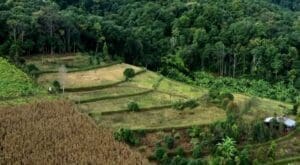
ied, it is not competing. It only used some of the nutrients the balance was used by the trees. Vetiver reduces the use of fertilizers by 50 percent. Most importantly, it also helps prevents fungus in the roots,” said Udon.
Phanom Chompol, a farmer from Galyani Vadhana District, Chiang Mai Province, received the 11th Royal Shield Award for the year 2018-2019 as a model of vetiver grass application in mountainous areas where annual crops are normally grown. Phanom confirmed that vetiver grass was really beneficial, especially on the hillside area. Planted as a line to slow down rainfall runoff, to collect sediment around the tree. On a slope he plants in a semicircle, an
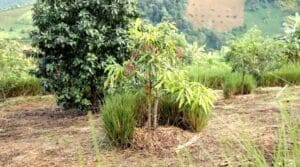
d on flat areas around the trees, to collect rainwater, create moisture and store nutrients. He notes that
weeding is necessary to assure faster plant growth.
Sanit Chao Pa Farmer, Uthai Thani Province was awarded the 12th royal shield for the year 2020-2023 as a model for planting vetiver grass to reduce sioil erosion in farms. Sanit said that in the past, he planted monoculture maize on his farm using chemicals. These have “burned” the soil for 20-30 years, never improving it, and in the end the soil was very bad. Crop yield was getting less and there was always erosion. He consulted with the
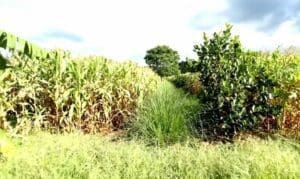
provincial land development staff and was recommended vetiver grass, planted as hedgerows within the maize field. The results were better, there is no more erosion rills, and vetiver helps to cover the soil surface and helps to create more moisture for the plants.
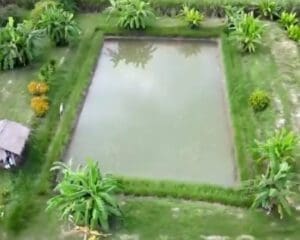
“All of this was made possible by His Majesty King Rama IX who bestowed royal initiatives. and has inspired us,” Sanit concluded.
Regenerative Agriculture from Vietnam
The Thai experience is being followed in Vietnam where members of The Vietnam Vetiver Farmers Group VIETNAM VETIVER FARMERS – have been trying out all sorts of vetiver crop configurations. Kiên Vũ Văn posted … “What is a symbiotic? Basically symbiotic is a relationship in which both parties have benefits, and we grow vetiver symbiotically with different crops for the main purpose of making our main crop grow better. In this relationship, vetiver plays a supportive role. As we know, when growing vetiver grass, the roots of vetiver are associated with symbiotic fungi mycorrhiza. Mycorrhiza:
- Transports water and mineral salts to the roots of the plant.
- Help to break down complex compounds in the soil into simple substances for plants to absorb.
- Prevent and control some types of harmful fungi
In short growing vetiver grass symbiotically has so many benefits, it:
- Helps associated plants to grow well
- Limits diseases
- Reduces irrigation and fertilizer
- Helps microbiome in the soil develop better
- Provides better drainage that reduces flooding” ….
He also points out that close planting of vetiver and young perennial plants can in the first year or so be a problem due to shading by the vetiver. So constant management (pruning) is needed. We recommend that you visit this Vietnamese Facebook group, they have lively and useful discussions on some of these issues
Regenerative Agriculture from Puerto Rico
“There are several methods that can be used to control soil erosion. Some of these are contour plantings, cover plants, physical barriers, shade trees, terraces, and stabilizing herbs or vegetative barriers. Stabilizing grasses provide roots that hold the soil in place making it resistant to the impact of water and wind. A “patchouli” (vetiver) barrier limits the flow of water by trapping soil particles. Such stabilizer grass can also be cut and used as mulch. It is recommended to plant them, along the contour, between the rows of coffee trees planted on steep slopes. Near the shores, and bodies of water, and in any area prone to soil erosion or landslides. Characteristics of patchouli (vetiver) make it ideal for erosion control. It is a plant that is not propagated by seeds, making it non-invasive. It has an extremely strong root system, reaching 6-10 feet deep, and can stabilize the soil even on steep slopes. Patchouli adapts very well to the conditions of our soil. It does not compete with coffee for its nutrients. It grows fast and can be easily propagated. It also requires little maintenance. The steps to plant patchouli are: (i) select mature, vigorous, and healthy patchouli plants; (ii) remove the bunch of patchouli from the ground; (iii) trim the leaves to 8 inches long and separate the large bunch into smaller ones with 3-4 tiller; (iv) dig a shallow furrow, on the contour, and plant patchouli 4-6 inches apart; (v) cover the roots with soil and compact well; (vi) Water well if it doesn’t rain and Weed regularly; (vi) prune patchouli to a foot height one or twice a year during rainy seasons, and always allow sunlight.” Aixalis Jordan (Puerto Rico) Control de Erosión con Pacholí
The above few examples show just how vetiver can be a key tool for farmers when shifting to regenerative practices. Don’t forget that there are other vetiver applications that are also very useful on the farm. Some of these are included in “Embedding Vetiver Grass Technology Into Farm Systems At Various Scales Under Tropical And Semi-Arid Conditions”.
Regenerative Agriculture Costa Rica — From Finca Cristina.
… “my personal opinion is that wherever there is water on our farm, vetiver is there to help us. I know my response may be too general for you, but our experience has been dealing with vegetative and animal waste (except for the city dump) rather than chemical. Good luck”, Linda Finca Cristina Paraiso, Costa Rica
Vetiver Short Video Competition – Winners Announced.
The Vetiver Short Video Competition has been completed and evaluated. We received 34 entries that were evaluated by 5 judges. The evaluations of all 34 videos can be found here. The overall winner will be determined through a poll of our Facebook group members during January 2023. Below are the first and second place videos listed by category (1= First, 2= Second), and with links to the respective video. (#=Video ID). Each will receive a US$500 award.
Community (total entries – 7)
1 Alois Kennerknecht/ ALKE, Peru. Vetiver Grass: Community Use in Urban Areas (#1)
2 Jonathan Barcant, Trinidad and Tobago. Grassroots 4LaVie Tobago (#7)
Disaster Mitigation (total entries – 3)
1 Estampa Verde, Mexico. The Vetiver System and Keyline – A climate risk management tool for agriculture. (#10)
2 Bunsita Sansila, Thailand. Vetiver Grass: A Climate Smart Plant .(#8)
Soil and water conservation (total entries – 7)
1 Suwimon Puttajunyawong, Thailand. Vetiver Grass: Environment Conservation. (#17)
2 Amnat Charoen Land Development Station, Thailand. Vetiver: The Living Wall for Conservation of Soil and Water. (#16)
Phytoremediation (total entries – 3)
1 Edwin Mariita, Kenya. Vetiver Latrine in Busia, Kenya. (#19)
2 Oswaldo Luque, Venezuela. Vetiver Biofilter System. (#20)
Agriculture (total entries – 6)
1 Piet Gustaaf Sabbe, Ecuador. Vetiver on Contour Lines in Your Farm and in the Landscape. (#21)
2 Highland Research and Development Institute, Thailand Planting Vetiver to Conserve the Soil and Adjusting Arable Land to Conserve Forests (#26)
Slope Stabilization (total entries – 5)
1 Marietta Isabel Landis, Panama. Sustainable Regeneration (#28)
2 Salvador Ramirez, Guatemala. Vetiver system protecting public and private infrastructure from landslides (#27)
Other Uses (total entries – 2)
1 Hanping Xia, Liyu Xu, Peng Wang, PR China. Vetiver for Human Beings — Vetiver Science Education for Children (#33)
2 Ngwainmbi Chia Simon, Cameroon. Vetiver Bi-Product (#32)
Handicrafts (total entries – 1)
1 Oswaldo Luque, Venezuela. Methodology Vetiver Handicrafts Projects in Venezuela (#34)
Research.
Two P450 genes, CYP6SN3 and CYP306A1, involved in the growth and development of Chilo suppressalis and the lethal effect caused by vetiver grass
Yanhui Lu, Qi Bai, Qiang Li, Xusong Zheng, Junce Tian, Jiawen Guo, Hongxing Xu *,Zhongxian Lu
ABSTRACT Chilo suppressalis is a widely distributed pest occurring in nearly all paddy fields, which has developed high level resistance to different classes of insecticides. Vetiver grass has been identified as a dead-end trap plant for the alternative control of C. suppressalis. In this study, two cytochrome P450 monooxygenase (P450) genes, CsCYP6SN3 and CsCYP306A1, were identified and characterized, which are expressed at all developmental stages, with the highest expression in the midguts and fat bodies of 3rd instar larvae. Vetiver significantly
inhibited the expression levels of CsCYP6SN3 and CsCYP306A1 in 3rd larvae after feeding. RNA interference showed that silencing CsCYP6SN3 and CsCYP306A1 genes dramatically reduced the pupation rate and pupa weight. Feeding on vetiver after silencing CsCYP6SN3 and CsCYP306A1 led to higher mortality compared with feeding on rice. In conclusion, these findings indicated that the expression levels of CsCYP6SN3 and CsCYP306A1 were associated with the lethal effect of vetiver against C. suppressalis larvae and functional knowledge about these two detoxification genes could provide new targets for agricultural pest control.
Uptake capacity of metals (Al, Cu, Pb, Sn, Zn) by Vetiveria Zizanioides in contaminated water in the Dong Xam metal production trade village, Thai Binh, Vietnam
Nguyen Trung Minh, Seong-Taek Yun, Jang-Soon Kwon, Doan Thu Tra, and Doan Dinh Hung
ABSTRACT The present study investigates an experiment of uptake capacity of metals by Vetiveria zizanioides to treat contaminated water from a metal production trade village, Dong Xam, Thai Binh, Vietnam (DXV). Vetiver was grown in two pot culture experiments TB10, TB6 with solutions containing respective concentrations of Al, Cu, Pb, Sn and Zn of 2.5, 55.6, 0.15, 7.7 and 24.4 mg from the DXV for a period of 36 days. Vetiver was higher tolerant to metals Al, Cu, Pb, Sn and Zn than other plant species. The roots (hereafter R) accumulated Al from 17 to 30 folds than that in “reference plant”. The upper parts of shoots (hereafter S1, S2, and S3) were 1.2 folds higher than that in “reference plant”. Cu concentrations in the roots and shoots were 660 and 46.2 mg/kg, respectively. Vetiver could withstand and survive at Cu concentration of 46 mg/L in contaminated water that is markedly higher than other plants. The translocation of Pb from root to shoot was 41%. Sn accumulated higher in the top, in which shoot/root ratio varied from 82 to 277% and increased to the top by order S3/R>S2/R>S1/R. Zn could be translocated from root and accumulated in shoot. The ratio shoot/root was up to 46%. The present results demonstrated that vetiver was high tolerant to metals Al, Cu, Pb, Sn and Zn. Therefore, vetiver has a potential phytoremediation of metals in contaminated soils and wastewaters from trade villages in Vietnam and other countries.
VETIVER SYSTEM AND ITS RESEARCH AND APPICATIONS IN CHINA
— CHINA VETIVER NETWORK Editors Liyu Xu, Changjiu Fang, Ming Wan, Charles P. (Todd) Chirko. The book with photos, remains a very useful account of the introduction of the Vetiver System (VS) to China and the research and development that was undertaken between 1988 and 2003. We recommend the book. It contains much information that remains useful today. It reflects the important role that the Chinese people and institutions have contributed to the global interest and development of the Vetiver System during the 21st century. Continuing VS research and development in China benefits us all.
Some Vetiver related videos
While browsing Youtube recently I came across these videos, some of which may be of interest. They are not all about vetiver grass, but address and set out systems that vetiver would well fit into and enhance.
Vetiver Grass Plants Resilience in Rural Kenya – Locally Led Adaptation Project
REVOLUTIONARY FARM1S #2: From barren field to lush food forest | Rongo, Kenya
Syntropic Agroforestry farm in Tanzania, one year later and a management class
Grass strips against soil erosion
Vetiver Grass- The Miracle Grass- Why Aren’t You Growing This?!
Here’s what you need to know about vetiver…
Biological Retaining Wall – Vetiver On Contour
VETIVER GRASS | Bioengineering Technique for Slope Stabilization | Civil Engineering & Construction
Control de Erosión con Pacholí
How to make vetiver handicraft products? (Basic)
Vetiver Emergency Ration for Skinny Cows
Características del Vetiver y su Importancia para el Cuidado del Agua- TvAgro por Juan Gonzalo Angel
Vetiver: Green Tech for the 21st Century
Previous Newsletters in 2022
July, August, September, October, November,